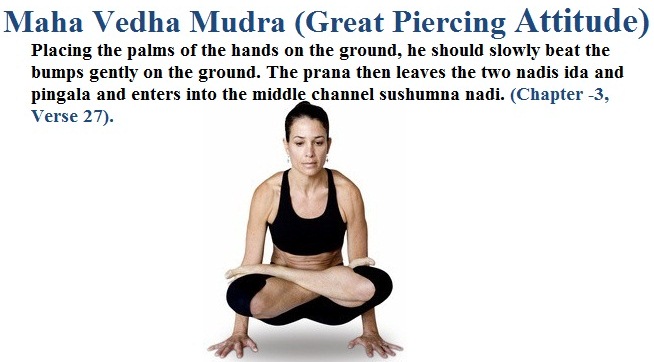Maha Vedha Mudra
Introduction
Maha Vedha Mudra is an advanced Hatha Yoga practice mentioned in the Hatha Yoga Pradipika and Gheranda Samhita. It is one of the Maha Mudras (great mudras) that powerfully influences prana and awakens higher states of consciousness. Maha Vedha involves a combination of asana, bandhas, kumbhaka (breath retention), and a dynamic movement of the body.
It is traditionally performed after Maha Mudra and Maha Bandha, and it acts as a catalyst to stimulate the Kundalini Shakti by directing prana into the central channel (Sushumna Nadi).
Meaning
Maha = Great, supreme.
Vedha = Piercing, penetration, striking.
Mudra = Seal or gesture.
Thus, Maha Vedha Mudra means the great piercing gesture, symbolizing the piercing of the three granthis (energy knots) that obstruct Kundalini:
Brahma Granthi (base, inertia),
Vishnu Granthi (heart, attachment),
Rudra Granthi (head, ego).
How to Perform (Practice)
Sit in padmasana. Relax the body and close the eyes. Place the palms of the hands on the floor beside the thighs with the fingers pointing forward or make fists with the knuckles facing down.
The arms should be straight but relaxed. Inhale slowly and deeply.
Retain the breath inside.
Raise the body by placing all the weight on the hands and straightening the arms.
Gently beat the buttocks on the ground 3 times, keeping the awareness at the perineum.
The buttocks and the back of the thighs should touch the ground simultaneously. The spine must be kept straight. Gently rest the buttocks back on the floor.
Exhale. This is one round. When the breathing returns to normal, repeat the process.
Practice 3 rounds.
Benefits
Physical Benefits
Stimulates pelvic and abdominal organs.
Improves circulation to reproductive and digestive systems.
Strengthens pelvic floor muscles.
Regulates glandular secretions (thyroid, adrenal, gonadal).
Energetic Benefits
Purifies nadis and removes blockages.
Directs prana into Sushumna Nadi.
Awakens Kundalini energy.
Dissolves the granthis (knots) of energy.
Mental & Spiritual Benefits
Increases concentration and meditation capacity.
Promotes detachment from material bondage.
Awakens higher states of consciousness.
Leads toward Samadhi (union with the self).
Contraindications
Not suitable for beginners.
Avoid in case of:
Hypertension,
Heart disease,
Hernia, ulcers,
Epilepsy,
Pregnancy.
Should not be performed after heavy meals.
Anatomy & Physiology
Musculoskeletal: Involves hip joints, spine, pelvic floor, and abdominal compression.
Endocrine: Stimulates thyroid, adrenal, and reproductive glands.
Respiratory: Increases tolerance to CO₂, strengthens diaphragm control.
Circulatory: Enhances venous return and arterial circulation in pelvic region.
Kinesiology
Movement: Upward lift of the body followed by gentle striking of buttocks on the ground.
Muscles involved:
Arm and shoulder muscles (for lifting support),
Pelvic floor muscles (Mula Bandha),
Abdominal muscles (Uddiyana Bandha),
Cervical flexors (Jalandhara Bandha).
Promotes stability, balance, and control.
Neurology
Stimulates sacral and lumbar nerve plexuses.
Activates parasympathetic nervous system (through Mula Bandha).
Jalandhara Bandha regulates vagus nerve activity (balances HR and BP).
Enhances higher brain centers → limbic system, pineal, pituitary → linked to altered states of consciousness.
Duration of Practice
Beginners (with guidance): 3 rounds of 10–20 seconds breath retention.
Intermediate/advanced: 5–7 rounds, gradually increasing kumbhaka time.
Best practiced early morning on an empty stomach, after Maha Mudra and Maha Bandha.
Counter Mudra
To balance its heating, stimulating effects, practice:
Shakti Mudra → calming, cooling.
Chin Mudra → grounding, meditative.
Varun Mudra → restores water balance.
Conclusion
Maha Vedha Mudra is one of the most potent yogic mudras, known as the great piercing gesture. It directs prana into Sushumna, pierces energy knots, and awakens Kundalini Shakti. It enhances physical health, purifies energy channels, and uplifts consciousness. However, it is an advanced practice and should be approached with caution and guidance.
FAQ
Q1. Can beginners try Maha Vedha Mudra?
No, it is recommended only for advanced practitioners under expert guidance.
Q2. Does it really awaken Kundalini?
Yes, it is one of the traditional mudras for Kundalini arousal.
Q3. Can women practice Maha Vedha Mudra?
Yes, but avoid during pregnancy and menstruation.
Q4. What is the difference between Maha Bheda and Maha Vedha Mudra?
Maha Bheda → static, inward piercing with bandhas and kumbhaka.
Maha Vedha → dynamic striking movement of buttocks with bandhas.
Q5. When should it be practiced?
After Maha Mudra and Maha Bandha, early morning, empty stomach, in a meditative environment.
References
Hatha Yoga Pradipika – Svātmārāma.
Gheranda Samhita.
Swami Satyananda Saraswati – Asana, Pranayama, Mudra, Bandha.
Kuvalayananda – Yoga Mimamsa Journal.
Swami Niranjanananda Saraswati – Prana and Pranayama.

